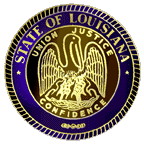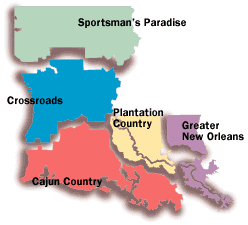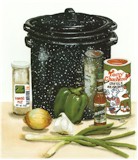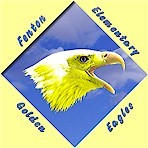Cajun Country History The French province of Acadia
(today's Nova Scotia and surrounding regions) was settled in the 1600s by
French colonists, but the area became a British possession soon
afterwards. In 1755, as war neared between France and England, the British
authorities demanded that the Acadians renounce their Roman Catholic faith
and swear allegiance to the Crown. The Acadians refused and the mass exile
that followed is well known to all who have read Henry Wadsworth
Longfellow's "Evangeline".
The French province of Acadia
(today's Nova Scotia and surrounding regions) was settled in the 1600s by
French colonists, but the area became a British possession soon
afterwards. In 1755, as war neared between France and England, the British
authorities demanded that the Acadians renounce their Roman Catholic faith
and swear allegiance to the Crown. The Acadians refused and the mass exile
that followed is well known to all who have read Henry Wadsworth
Longfellow's "Evangeline".
 The
migration of the French Acadians to Louisiana was neither smooth nor
immediate. Many were shipped to the New England colonies, others to the
West Indies or back to France, and many wandered for 20 years before
learning that they were welcome in the predominantly French territory of
Louisiana. Here they established small farms along the Mississippi River,
Bayou Teche, Bayou Lafourche and other streams in the southern part of the
region. Fishing and trapping villages were established in the swamplands.
Cajun (the word is a corruption of the original French pronunciation of
Acadian--A-ca-jan) Country today lies within a triangle whose base is the
Louisiana coast and whose apex is near Alexandria in the central part of
the state. The triangle contains 22 parishes and the region's principal
city, Lafayette, is the unofficial capital of "Acadiana". The
migration of the French Acadians to Louisiana was neither smooth nor
immediate. Many were shipped to the New England colonies, others to the
West Indies or back to France, and many wandered for 20 years before
learning that they were welcome in the predominantly French territory of
Louisiana. Here they established small farms along the Mississippi River,
Bayou Teche, Bayou Lafourche and other streams in the southern part of the
region. Fishing and trapping villages were established in the swamplands.
Cajun (the word is a corruption of the original French pronunciation of
Acadian--A-ca-jan) Country today lies within a triangle whose base is the
Louisiana coast and whose apex is near Alexandria in the central part of
the state. The triangle contains 22 parishes and the region's principal
city, Lafayette, is the unofficial capital of "Acadiana".
 Cajun
cooking may be a first cousin to the Creole cuisine of New Orleans, but
there is none other quite like it in the world for the imagination of its
dishes or the artistic robustness of its seasoning. Favorite Cajun dishes
include jambalaya, gumbo, turtle sauce piquante, andouille sausage, boudin
(a pork and rice sausage), cochon du lait, soft-shell crab, stuffed crab,
a hundred shrimp dishes, crawfish etouffee, crawfish bisque, crawfish pie,
and dozens more. Cajun
cooking may be a first cousin to the Creole cuisine of New Orleans, but
there is none other quite like it in the world for the imagination of its
dishes or the artistic robustness of its seasoning. Favorite Cajun dishes
include jambalaya, gumbo, turtle sauce piquante, andouille sausage, boudin
(a pork and rice sausage), cochon du lait, soft-shell crab, stuffed crab,
a hundred shrimp dishes, crawfish etouffee, crawfish bisque, crawfish pie,
and dozens more.
 Cajun music can be lively or melancholy and sometimes both at once. The
traditional instruments are fiddle, accordion and triangle, and those
still dominate (although drums and guitars have found their way into Cajun
bands in recent years). Like the spoken language of the Cajuns, the lyrics
of their songs are part French, part English. The themes are universal,
love (lost and found) and the beauty of their land, but the melodies and
phraseology are unique.
Cajun music can be lively or melancholy and sometimes both at once. The
traditional instruments are fiddle, accordion and triangle, and those
still dominate (although drums and guitars have found their way into Cajun
bands in recent years). Like the spoken language of the Cajuns, the lyrics
of their songs are part French, part English. The themes are universal,
love (lost and found) and the beauty of their land, but the melodies and
phraseology are unique.
Originally farmers, trappers and fishermen, today's Cajuns occupy virtually every occupation and are the backbone of the state's oil and gas exploration and production industry, particularly offshore. When oil was first discovered in the North Sea more than 5,000 Cajuns with experience working on oil rigs in the open sea were employed to drill the first wells and to provide training. Along with its food and music, the major trademarks of Cajun Country are pirogues (canoes made from a single cypress log), Spanish moss, alligators, swamps, bayous and "Cajun Cabins". The Acadian Flag A
symbol of ethnic pride, the golden star on the white field symbolizes
Acadian patriotism and also carries deep religious significance. It
represents patriotism because exiled Acadians in Louisiana, under Spanish
governor-general Bernardo de Galvez, engaged British forces during the
American Revolution and helped to capture strategic points at Manchac,
Baton Rouge, Mobile, and Pensacola. The star and field also symbolize the
Acadians' strong Roman Catholic heritage. The silver fleurs de lis on a
blue field symbolize the Acadians' French ancestry. And the golden castle
on the field of red represents Louisiana's period of Spanish colonial
rule, during which the Acadians arrived in Louisiana. A
symbol of ethnic pride, the golden star on the white field symbolizes
Acadian patriotism and also carries deep religious significance. It
represents patriotism because exiled Acadians in Louisiana, under Spanish
governor-general Bernardo de Galvez, engaged British forces during the
American Revolution and helped to capture strategic points at Manchac,
Baton Rouge, Mobile, and Pensacola. The star and field also symbolize the
Acadians' strong Roman Catholic heritage. The silver fleurs de lis on a
blue field symbolize the Acadians' French ancestry. And the golden castle
on the field of red represents Louisiana's period of Spanish colonial
rule, during which the Acadians arrived in Louisiana.
I'm now living in Jefferson Davis Parish, Village of Fenton, 220 miles west of New Orleans. Jeff Davis Parish offers Interstate 10 travelers a unique opportunity. Headed east, a first glimpse of the region known as Acadiana. Headed west, a last chance to explore and experience the Cajun culture. Settled in the 1800s, Jennings, Lake Arthur, Welsh, Village of Fenton, and Elton are towns which reflect Midwestern influence blended with the rich culture and traditions of Southwest Louisiana's people and its diverse landscape. Stroll down brick sidewalks with gaslights. See National Historic Register homes, Victorian architecture, unique museums, a replica of the state's first oil well, scenic byways, Coushatta Indians, a wildlife refuge and lake surrounded by 100-year-old moss draped oaks. See live alligators (we'll even let you hold one!) and Rambeaux, our 100-year-old, 100-pound turtle. Enjoy authentic Cajun gumbo, jambalaya and boudin. No matter which direction you are heading, don't miss Jeff Davis Parish! For more information, contact: Jeff Davis Parish Tourist Commission, LA Gas & Oil Park, P.O. Box 1207, Jennings, LA 70546, (318) 821-5521, (800) 264-5521. Credit: Louisiana Office of Tourism. © 1997 Écu Media Design.  History of Fenton School.  More Cajun History. Music playing "Ville Platte 2 Step Waltz" by Accordian Man. Permission by © Accordion Man All Rights Reserved. For the best Cajun MIDI Music visit Accordion Man.
|